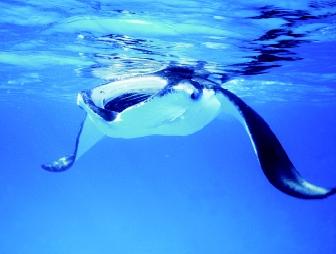Fishes, Cartilaginous
Sharks, rays, and chimaeras or ratfishes make up the cartilaginous fishes (Chondrichthyes), one of the two major groups of fishes. The other major group is the ray-finned fishes (Actinopterygii). Unlike the more familiar rayfinned fishes, the cartilaginous fishes have skeletons composed entirely of cartilage. Moreover, cartilaginous fishes possess teeth that are replaced on a regular basis: a single shark may produce over ten thousand teeth in its lifetime. Cartilaginous fishes have four to seven pairs of gill slits that open separately to the outside (except chimaeras have a flap-like covering over the gill slits), lack a swim bladder, and practice internal fertilization (union of sperm and egg).
Compared to ray-finned fishes, cartilaginous fishes are relatively large, produce few young, mature slowly, and include a relatively low number of species . Chondrichthyes produce fewer than two hundred young per year and many reproduce every other year. Maturity in Chondrichthyes is attained from after several years of life to over 20 years of life. There are an estimated 934 species of cartilaginous fishes compared to about 22,000 species of ray-finned fishes. The low reproductive rates and slow rates of maturity make these fishes vulnerable to overfishing, and some species have declined to the point of concern.
Scientists estimate that there are about 383 species of sharks, 516 species of rays, and 35 species of rarely seen chimaeras. With the exception of the

Rays and Skates
Rays and skates are distinguished from sharks in having their pectoral fins connected to the sides of their heads to form a disc, and gill slits are located on the ventral (underneath) side of the body. They are moderately to extremely flat and have rather stout to very slender tails, and are classified according to specializations. Electric rays are flattened but rather thick-bodied and have stout to moderately stout tails, with their gill arch muscles modified into electric organs (from which they can generate a shock of up to 200 volts). The electric organs are used to stun prey and defend against predators
Sawfishes and guitarfishes are shark-like, with rounded, wedge-shaped, or blade-rostrums. Sawfishes are distinguished from guitarfishes by the teeth on each side of their blade-rostrum.
Skates have guitarfish-rostrums and a broad disc, with bi-lobed pelvic fins and electric organs on each side of their slender tail. The skates use their electric organs for communication.
Stingrays have a broad disc, with single-lobed pelvic fins, and generally a serrated spine on the base of the tail. The tail spines are used in defense against predators.
Skates and rays with stout tails (electric rays, guitarfishes, and sawfishes) swim by undulating their tails from side to side. Skates and more generalized stingrays swim by undulating the margin of their disc. The more specialized stingrays swim by flapping their disc like birds in flight.

Sharks
Sharks are elongate, stout-bodied, and more uniform is shape than the skates and rays. They lack a connection between the pectoral fins and the sides of the head, and the gill slits are laterally located. Benthic species are moderately flattened, whereas pelagic species are streamlined. They are also divided into a number of subgroups, but the subgroups are not clearly distinguished by obvious specializations as in the case of the rays.
One group of sharks, termed the dogfish (Squalomorphii) generally possesses a spine preceding each dorsal fin and lives at high latitudes or in deep water. The remainder of sharks (Galeomorphii) are variable is shape but generally live at low latitudes. Most species live in water on or over the continental shelves, but some live at great depths.
The galeomorphs include the sluggish nurse sharks that occur around coral reefs; the large basking and whale sharks that feed by filtering zoo-plankton; and the white, mako, requiem, and hammerhead sharks that are pelagic predators.
The smallest shark, Etmopterus perryi, is 16 to 20 centimeters (6 to 8 inches) in length, and the largest, the whale shark ( Rhincodon typus ), is 12 meters (about 40 feet), making it the largest of all fishes.
SEE ALSO Coastal Ocean ; Corals and Coral Reefs ; Fish ; Life in Water .
John D. McEachran
Bibliography
Moyers, Peter B., and Joseph J. Cech, Jr. Fishes: An Introduction to Ichthyology, 4th ed. Englewood Cliffs, NJ: Prentice Hall, 1999.
Stevens, John, and Peter R. Last. "Sharks, Rays, and Chimaeras." In Encyclopedia of Fishes, eds. J. R. Paxton and W. N. Eschmeyer. New York: Academic Press, 1994.
OVERRATED SHARK ATTACKS
Sharks can and do attack humans, although the risk of dying from a shark bite is miniscule: about 1 percent of the risk of being killed by lightning. Worldwide, only about one to two dozen deaths by shark attack occur annually.
In contrast, an estimated 30,000 human illnesses occur each year when people eat poisonous fish, shellfish, and other marine animals. In Japan alone, about 100 people die each year from pufferfish poisoning, even though the dangers of consuming this fish are well known.
Comment about this article, ask questions, or add new information about this topic: